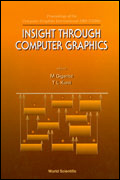System Upgrade on Tue, May 28th, 2024 at 2am (EDT)
Existing users will be able to log into the site and access content. However, E-commerce and registration of new users may not be available for up to 12 hours.For online purchase, please visit us again. Contact us at customercare@wspc.com for any enquiries.
Computer graphics has been advancing to the level of creating completely new worlds inside computers. Through such computer graphics worlds, we human beings now have far improved insight into wide varieties of real worlds starting from fairly simple but exact worlds of curves and surfaces and reaching to complex human worlds. This volume presents a quite concrete and advanced methods, techniques, modeling and mathematical backgrounds which are indispensable in order to carry out end researches to increase insight through computer graphics.
Contents:
- Graphic Systems:
- Three-Dimensional Mosaic Generations (M Inakage & H Inakage)
- How Does D-ABDUCTOR Support Human Thinking Processes? (K Misue & K Sugiyama)
- Statistical Pattern Classification in Computer Recognition of Sign Language (G D Roberts & M A Gigante)
- Modelling:
- A Model of Protozoan Movement for Artificial Life (A Dorin & J Martin)
- Human Skin Deformation from Cross-Sections (J H Shen et al.)
- A Virtual Paper Folding Simulator with Curved Surfaces (S-Y Miyazaki et al.)
- Rendering and Display:
- Interactive Real-Time Motion Blur (M M Wloka & R C Zeleznik)
- Dynamic Color Quantization of Video Sequences (E Roytman & C Gotsman)
- Ray Tracing Gregory-Type Patches (K T Miura)
- A Parallel Ray Tracing Algorithm Using Hierarchical Bounding Volumes (W Lamontte et al.)
- Visualization:
- A Unified Approach to Interface Design for Data Visualization Using Desktop and Immersion Virtual Environments (R R Dickinson & M Jern)
- N-Land: A Graphical Tool for Exploring N-Dimensional Data (M O Ward et al.)
- PISTON — A Scalable Software Platform for Implementing Parallel Visualization Algorithms (K K Tsui et al.)
- Shading and Illumination:
- Modelling Light Sources for Accurate Simulations (P Deville et al.)
- Illuminating the Free Space Between Quadrilaterals with Point Light Sources (G Blanco et al.)
- Interactive Rendering System for Line Drawings by Dot and Line Shading (A Kanbara et al.)
- Animation:
- Terrain Adaptive Human Walking (K Tsutsuguchi et al.)
- High Speed Image Generation with Motion Parallax in Virtual Space: A Viewpoint-Dependent Hierarchical Tree Shape Representation (N Kuwahara et al.)
- A Rapid Animation Tool (M Hayashi et al.)
- Image Processing:
- An Improvement to the Classical Wiener Filter to Image Restoration (S Suthaharan)
- Three Configurations of Network Detections for Binary Images of the Hexagonal Grid (Z J Zheng)
- Curves and Surfaces:
- Adaptive Polygonization of Cao En Surfaces (G Wyvill & D McRobie)
- Adaptive Isocurves Based Rendering: The Hardware Way (G Elber)
- On Using Curvature Characteristics for Polygonal Models (I Ihm et al.)
- and other papers
Readership: Computer scientists.






















